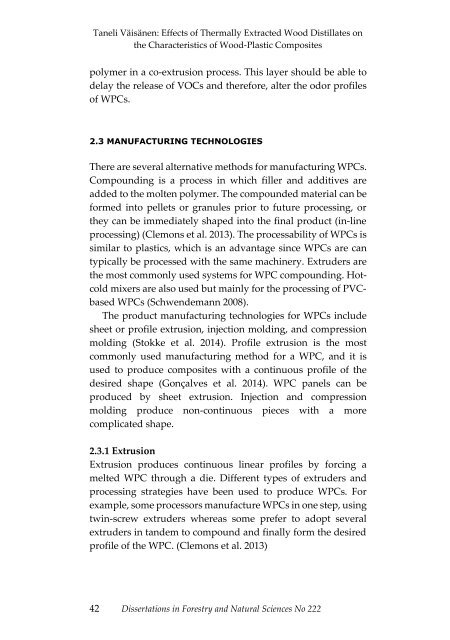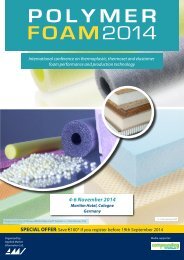Dissertations in Forestry and Natural Sciences
24lYKFN
24lYKFN
You also want an ePaper? Increase the reach of your titles
YUMPU automatically turns print PDFs into web optimized ePapers that Google loves.
Taneli Väisänen: Effects of Thermally Extracted Wood Distillates on<br />
the Characteristics of Wood-Plastic Composites<br />
polymer <strong>in</strong> a co-extrusion process. This layer should be able to<br />
delay the release of VOCs <strong>and</strong> therefore, alter the odor profiles<br />
of WPCs.<br />
2.3 MANUFACTURING TECHNOLOGIES<br />
There are several alternative methods for manufactur<strong>in</strong>g WPCs.<br />
Compound<strong>in</strong>g is a process <strong>in</strong> which filler <strong>and</strong> additives are<br />
added to the molten polymer. The compounded material can be<br />
formed <strong>in</strong>to pellets or granules prior to future process<strong>in</strong>g, or<br />
they can be immediately shaped <strong>in</strong>to the f<strong>in</strong>al product (<strong>in</strong>-l<strong>in</strong>e<br />
process<strong>in</strong>g) (Clemons et al. 2013). The processability of WPCs is<br />
similar to plastics, which is an advantage s<strong>in</strong>ce WPCs are can<br />
typically be processed with the same mach<strong>in</strong>ery. Extruders are<br />
the most commonly used systems for WPC compound<strong>in</strong>g. Hotcold<br />
mixers are also used but ma<strong>in</strong>ly for the process<strong>in</strong>g of PVCbased<br />
WPCs (Schwendemann 2008).<br />
The product manufactur<strong>in</strong>g technologies for WPCs <strong>in</strong>clude<br />
sheet or profile extrusion, <strong>in</strong>jection mold<strong>in</strong>g, <strong>and</strong> compression<br />
mold<strong>in</strong>g (Stokke et al. 2014). Profile extrusion is the most<br />
commonly used manufactur<strong>in</strong>g method for a WPC, <strong>and</strong> it is<br />
used to produce composites with a cont<strong>in</strong>uous profile of the<br />
desired shape (Gonçalves et al. 2014). WPC panels can be<br />
produced by sheet extrusion. Injection <strong>and</strong> compression<br />
mold<strong>in</strong>g produce non-cont<strong>in</strong>uous pieces with a more<br />
complicated shape.<br />
2.3.1 Extrusion<br />
Extrusion produces cont<strong>in</strong>uous l<strong>in</strong>ear profiles by forc<strong>in</strong>g a<br />
melted WPC through a die. Different types of extruders <strong>and</strong><br />
process<strong>in</strong>g strategies have been used to produce WPCs. For<br />
example, some processors manufacture WPCs <strong>in</strong> one step, us<strong>in</strong>g<br />
tw<strong>in</strong>-screw extruders whereas some prefer to adopt several<br />
extruders <strong>in</strong> t<strong>and</strong>em to compound <strong>and</strong> f<strong>in</strong>ally form the desired<br />
profile of the WPC. (Clemons et al. 2013)<br />
42 <strong>Dissertations</strong> <strong>in</strong> <strong>Forestry</strong> <strong>and</strong> <strong>Natural</strong> <strong>Sciences</strong> No 222



